Today we’ll look at the oldest places in Missouri. You know the iconic Gateway Arch and have probably tasted Missouri barbecue. But that’s not all there is to the Show Me State. Dubbed Mother of the West, the Midwestern state is significant in America’s history and contributed to its westward expansion. It was the starting point for the Pony Express, Oregon Trail, Santa Fe Trail, Butterfield Overland Mail Route, and California Trail.

State History of Missouri
Missouri and Tennessee hold the record for being the two states with the most neighbors; they are both bordered by eight states. Missouri has Arkansas to the south and Iowa to the north. Oklahoma, Kansas, and Nebraska are on the west of Missouri, with Kentucky and Tennessee to the east.
From the days of its existence as the Missouri Territory to 1821, when it was admitted to the Union, Missouri’s rich documented history precludes its current status as the 19th most populous state in the country with 114 counties.
Between the 1600s and statehood, the region that would become Missouri was a part of multiple distinct territories, had borders that frequently changed, and went by various Native American and European names.
The west bank of the Mississippi River, which would become Missouri, was largely uninhabited for the majority of the first half of the 1700s, serving as something of a buffer between Illinois on the east bank of the Mississippi River and to the north and the Osage and Missouri Indians of the lower Missouri Valley.
French traders and missionaries explored the entire Mississippi Valley in the early 1700s and named the area “Louisiana.” Then, they established Ste Genevieve and St Louis cities in 1735 and 1764, respectively. Finally, in 1803 as part of the Louisiana Purchase, the US acquired Missouri, previously under a short-lived Spanish control.
These two cities and more are rich in the state’s heritage and tell century-old tales of its existence.
5 Oldest Cities In Missouri
#1 Ste. Genevieve
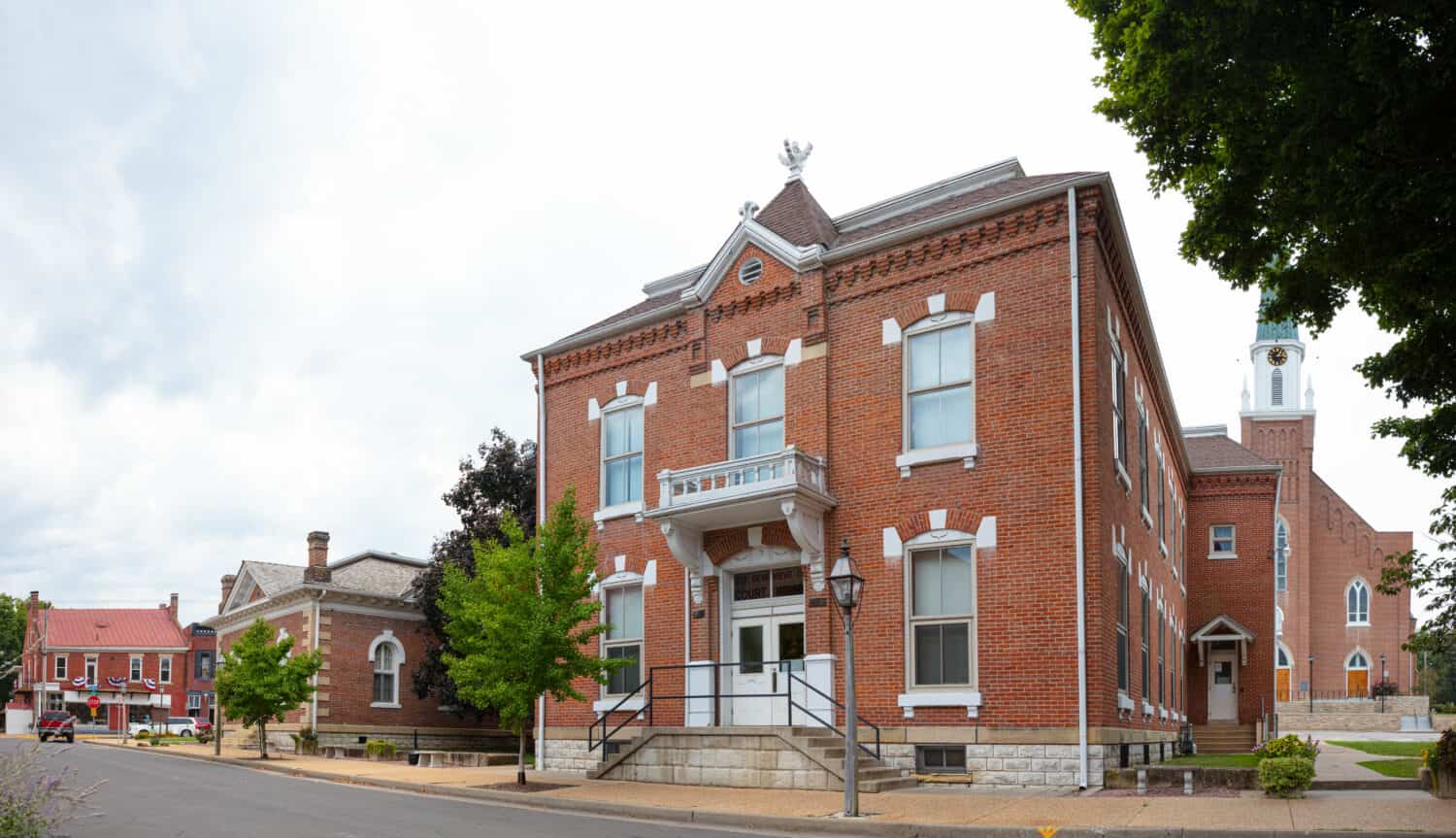
Ste. Genevieve is one of the oldest cities in Missouri, and several of its historical buildings still stand today.
©Roberto Galan/Shutterstock.com
Ste. Genevieve is the first established European settlement west of the Mississippi River in modern-day Missouri, founded by French Canadian colonists from east of the river. Former names for this region include Upper Louisiana Territory, Illinois Country, and New France.
The Louisiana Purchase in 1803 and Missouri’s statehood in 1821 marked the official incorporation of Ste. Genevieve into the United States and Missouri, respectively. It is the county seat of Ste. Genevieve County in Missouri with a population of about 5,000 people as of 2020.
It was named Saint Genevieve after the patron saint of Paris. Ste. Genevieve National Historical Park, the 422nd National Park Service (NPS) unit, is now located there.
According to the NPS, Le Grand Champ, a fertile agricultural potential, attracted the first residents to Ste. Genevieve. The land gave adequate room away from the water for grazing animals, cutting wood, and strip farming, as well as allowing inhabitants to use the river for various reasons.
Another reason for settling was the availability of fresh soil, which was harder to come by east of the Mississippi River.
The city was established in accordance with farming practices that the French considered successful in the Middle Ages. As a result, it flourished as an agricultural community specializing in producing wheat, maize, and tobacco.
However, after the great flood of 1785, Ste. Genevieve was forced to relocate from its original location on the Mississippi River floodplain to its current location two miles north and roughly a half mile inland.
The oldest surviving buildings in the city were constructed in the late 18th century while Spain was in power. The 1792-built Louis Bolduc House, which has been named a National Historic Landmark, is one such building.
Around 1770, Louis Bolduc first constructed a modest home at Ste. Genevieve’s first riverfront location. After the flood, parts of the house were removed and relocated north as the city began developing the new site in 1785. Bolduc used these materials to construct his new, grander home between 1792 and 1793.
Other significant structures on the National Register of Historic Places include the 1790s Bequette-Ribault House, the 1792 Beauvais-Amoureux House, the 1806 La Maison de Guibourd Historic House, the 1808 Old Louisiana Academy, and the 1818 Felix Vallé House State Historic Site.
#2 St. Louis
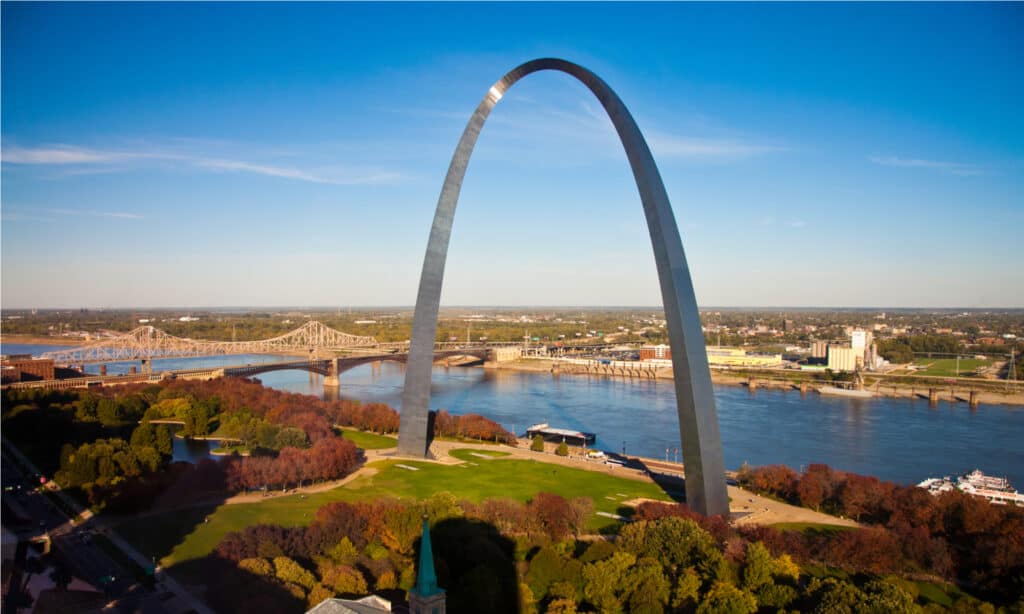
St. Louis is one of the oldest cities in Missouri.
©amolson7/Shutterstock.com
St. Louis was the second permanent European settlement and has remained the state’s second-oldest city. The region was a hub for Mississippian Native American civilization before European settlers arrived.
On February 15, 1764, Pierre Laclede, his stepson Auguste Choteau, and other fur traders founded St. Louis, named after King Louis IX of France. The city swiftly rose to prominence as the heart of the old Illinois Country after being established along the western bank of the Mississippi.
France lost the region to Spain in 1764 when it was defeated in the Seven Years’ War. However, France reclaimed it in 1800, and three years later, as part of the Louisiana Purchase, France sold it to the United States.
St. Louis evolved into an important port on the Mississippi River in the 19th century, ranking as the nation’s fourth-largest city from 1870 until the 1920 Census. Then, in 1877, it became autonomous with limited political boundaries after separating from St. Louis County.
It was the first non-European city to host both the World’s Fair and Summer Olympics in 1904. Many permanent buildings and facilities from the fair are still at Forest Park. Some include the St. Louis Palace of Fine Arts, The “flight cage” aviary at the St. Louis Zoo, and the concrete fence running along Forest Park Boulevard.
Today, St. Louis is the second-largest city in the state, with 301,578 inhabitants as of 2020. The Gateway Arch, the city’s most recognizable landmark, expresses St. Louis’ significance in the nineteenth-century American Westward Expansion.
#3 St Charles
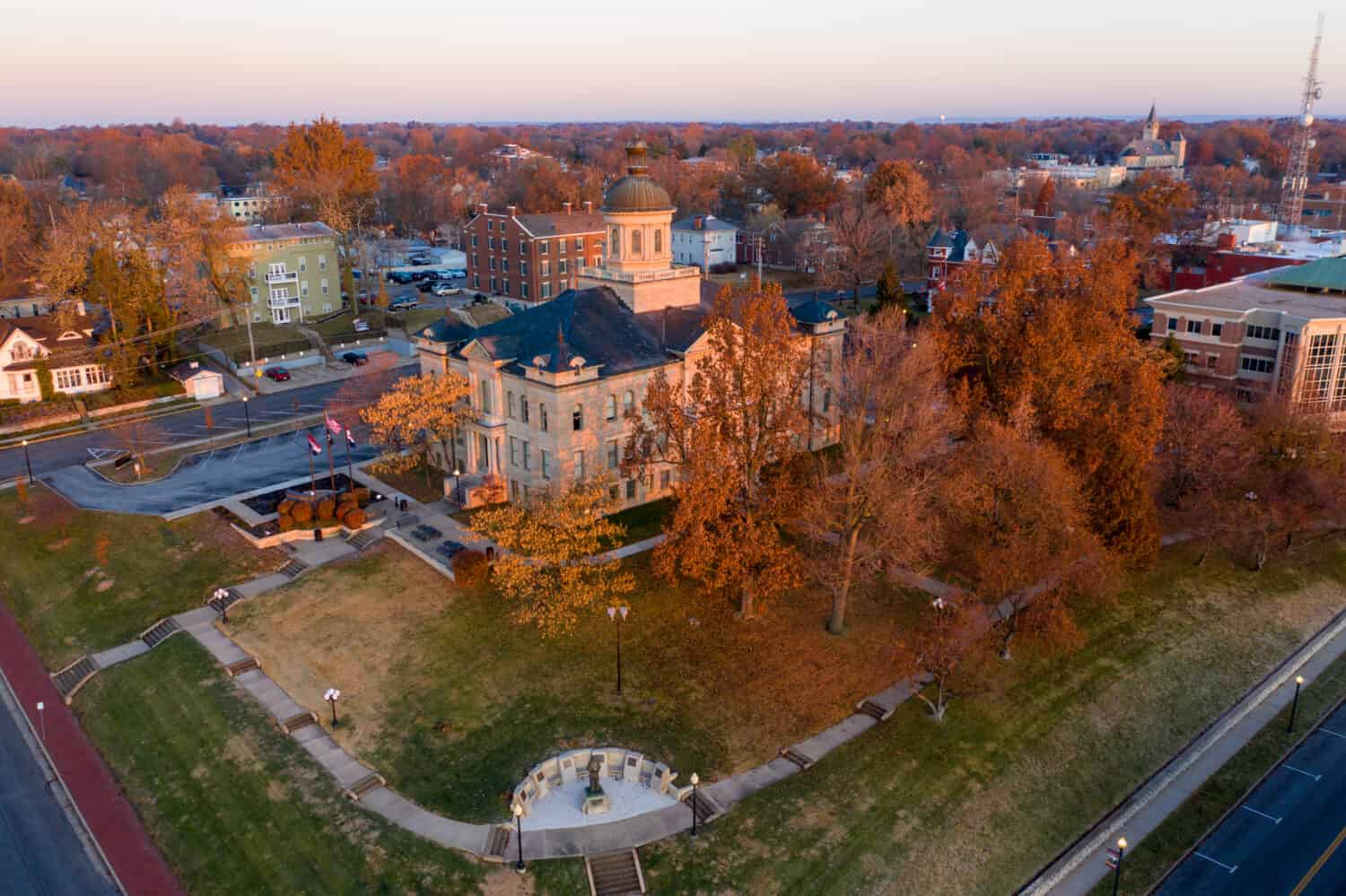
St. Charles is one of the largest and oldest cities in Missouri.
©RN Photo Midwest/Shutterstock.com
The French-Canadian fur trader Louis Blanchette established St. Charles as Les Petites Côtes (The Little Hills) in 1769, making it the third-oldest city in Missouri and the oldest settlement on the Missouri River. French-speaking colonists from Canada mainly colonized the city, and the Boone’s Lick Road, which led to the Boonslick, began there.
It had a considerable impact on the westward expansion of the United States for a while, serving as a river port and facilitating trade with Native American tribes on the upper Missouri River.
The Lewis and Clark expedition regarded it as the final “civilized” stop on their exploration of the western territory following the Louisiana Purchase.
St. Charles was home to Missouri’s first capital from 1821 to 1826. It was picked above eight other cities in a contest for the right to host the interim capital. The Missouri government held meetings there until 1826 when Jefferson City’s structures were finished.
The inaugural capitol building is about a block from the Missouri River on Main Street. Since being added to the National Register of Historic Places in 1969, the structure has been maintained as the First Missouri State Capitol State Historic Site.
The St. Charles Odd Fellows Hall is an 1878 Second Empire-style structure that is a part of the St. Charles Historic District. It was added to the National Register of Historic Places in 1987 and has served as a clubhouse, auditorium, and financial institution.
#4 New Madrid
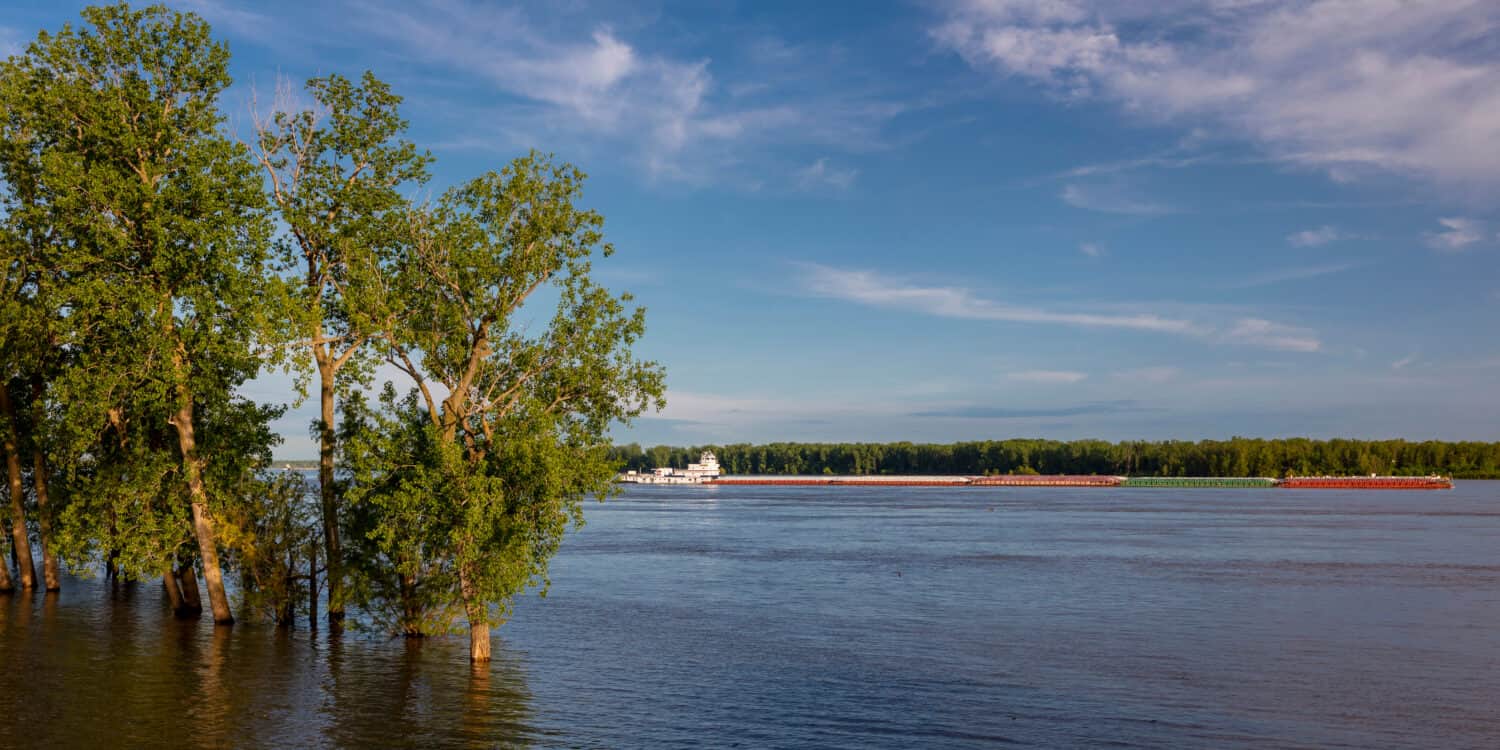
New Madrid, Missouri is located on the Mississippi River’s Kentucky Bend
©Joseph Sohm/Shutterstock.com
The Shawnee, Delaware, Creek, and Cherokee tribes were the first to settle in what is now New Madrid, following their displacement due to the American War for independence. In the early 1980s, several displaced Native American tribes agreed to accept Spanish settlement proposals on the Mississippi River’s west bank.
The area was renamed New Madrid by European Americans around the 1780s under the direction of Manuel Pérez, the lieutenant governor of Upper Louisiana in Saint Louis, and Spanish Governor Bernardo de Gálvez, who was chosen to govern Spanish Louisiana (the territory west of the Mississippi River).
Although they welcomed American settlers, they mandated that they submit to the Spanish throne. They also had to consent to live under the authority of Colonel George Morgan, a New Jersey-born American Revolutionary War veteran designated as his impresario.
A few hundred people moved to the area because Morgan recruited some American families to establish themselves in the city. However, the geography of the city and its surrounding areas meant that settlement remained relatively low in the 1790s and early 1800s.
With the Third Treaty of San Ildefonso, signed in 1800, Spain returned the region to France after attempting to retake Saint-Domingue (modern-day Haiti), where a slave uprising was in progress. He consented to transfer New Madrid to the United States in 1803 in the Louisiana Purchase.
New Madrid is located on the northern bank of the Mississippi River’s Kentucky Bend, commonly called “New Madrid Bend” or “Madrid Bend.” An outlying area of Kentucky’s Fulton County is encircled by the river, which curls in an oxbow.
It is known for its proximity to the Battle of Island Number Ten site, a Civil War military battle along the Mississippi River.
It was also the scene of one of the worst earthquake sequences ever recorded in the United States between 1811 and 1812. Over 1,000 earthquakes with magnitudes up to 8 occurred within a brief period, making it the strongest non-subduction zone earthquake in American history. Even the East Coast felt the powerful tremor.
#5 Florissant
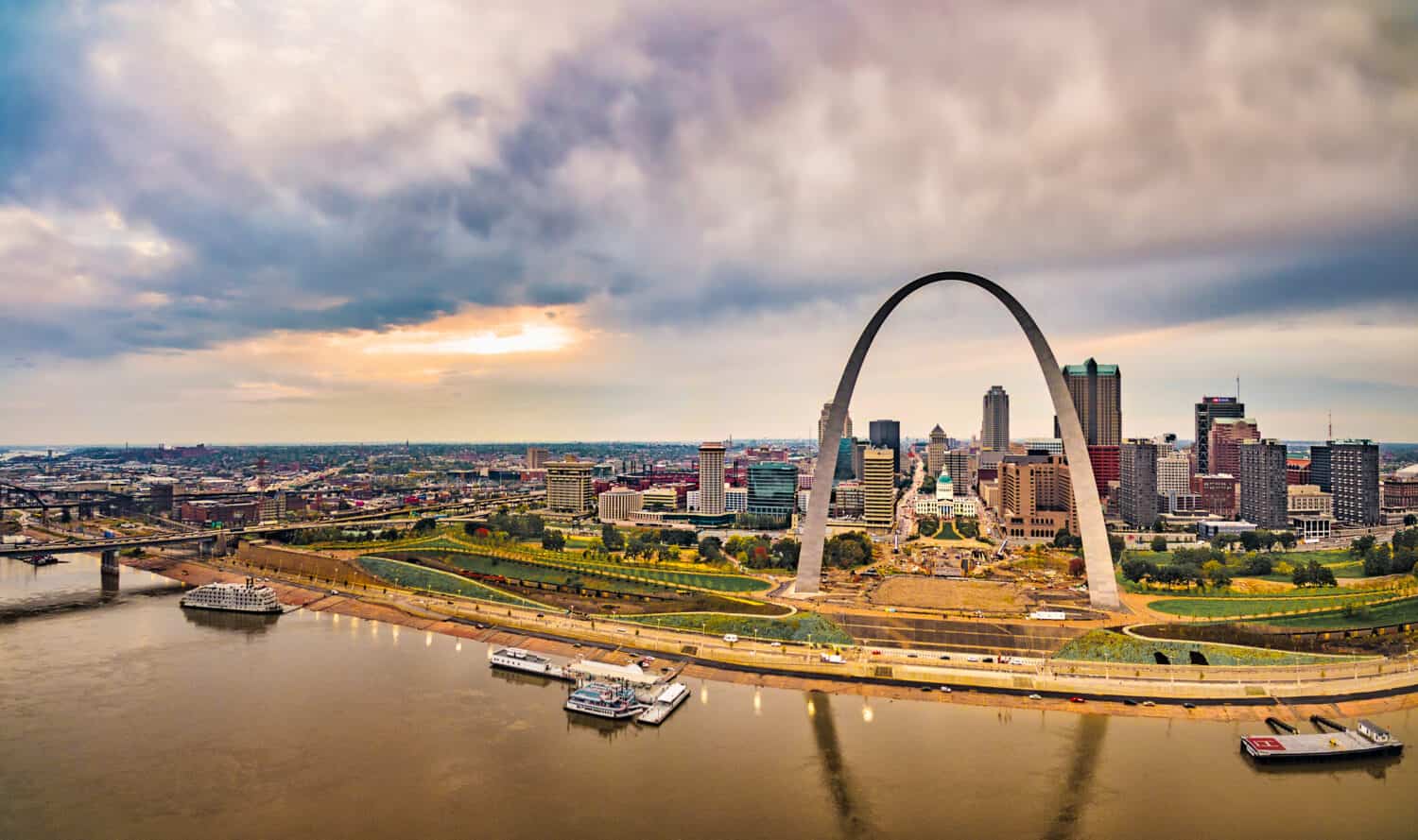
Florissant is a suburb of St. Louis and was named after the French word for “blooming.”
©James Roblee/Shutterstock.com
It is unknown when Florissant was first inhabited, although it is thought that it was sometime in the middle of the eighteenth century. According to some historians, its founding coincides with that of St. Louis. The first civil administration in the city was established in 1786. According to Spanish archives in Havana, forty individuals and seven plantations were present in Florissant in 1787.
The longest growth phase for Florissant, one of Missouri’s oldest communities, was following World War II when more than 18,000 homes were constructed between 1947 and 1980.
The settlement was a typical French community with commons and common fields. The French immigrants called it Fleurissant, French for “Blooming,” and the Spanish authorities called it “St. Ferdinand.” The city was built around and commonly named after the parish of St. Ferdinand. It was once independent but is now an inner suburb of St. Louis.
The historic Old St. Ferdinand Shrine can be found on the western edge of Old Town. The 1819 convent, 1821 Church, 1840 rectory, and 1888 schoolhouse are the four ancient structures of the Shrine and Historic Site. They all have separate listings on the National Register of Historic Places.
The Cold Water Cemetery is another historic place; the first burial occurred around 1809. It has been recognized for its social history by being included on the National Register of Historic Places since 2004.
Florissant is a second-ring northern, middle-class suburb of St. Louis. With a total population of 52,533 as of 2020, Florissant ranks as the largest municipality in St. Louis County and the twelfth-largest city in the state.
Summary Of The 5 Oldest Cities In Missouri
| Rank | City |
|---|---|
| 1 | Ste. Genevieve |
| 2 | St. Louis |
| 3 | St. Charles |
| 4 | New Madrid |
| 5 | Florissant |
The photo featured at the top of this post is © Roberto Galan/Shutterstock.com
Thank you for reading! Have some feedback for us? Contact the AZ Animals editorial team.






